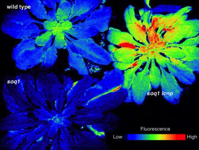
For plants, light is great, until it’s not. They need the sun’s energy to carry out photosynthesis, but too much light damages the chloroplasts in plant cells where light, water, and carbon dioxide are converted into sugar and oxygen. One way plants protect themselves is to dissipate that excess light, a process that also occurs in the chloroplasts.
Image: After a cold and high light stress, thale-cress plants (wild-type and soq1) display less chlorophyll fluorescence, equivalent to more energy dissipation. Researchers found that mutant plants with deficient levels of the lipocalin protein (soq1 lcnp) display high chlorophyll fluorescence. This indicates that LCNP is required for energy dissipation. (Credit: Alizée Malnoë/Berkeley Lab)

